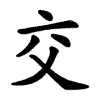交
- to associate, to meet, to make friends;
- to intersect, to exchange, to cross;
It conveys both the literal sense of things crossing or intersecting and the figurative sense of human interaction and social bonds.
Etymology
The character 交 depicts two elements crossing each other, suggesting intersection, mingling, or contact. From this, the meanings of exchange, intercourse, friendship, and interaction developed.
Semantic range:
- to make friends, to associate socially;
- to exchange, to give and receive;
- to intersect, to cross paths;
- alternation, mutuality (alternating, taking turns);
- by extension, intercourse or relations (physical or symbolic).
Usage in Korean
交流 (교류) — exchange, interchange, communication
交友 (교우) — making friends
交通 (교통) — traffic, communication, transport
社交 (사교) — social interaction
交替 (교체) — alternation, rotation
Words that derived from 交
- 교류(交流)–mixture of currents; intersection of streams; exchange; interchange; alternating current
- 교차(交叉)–crossing; intersection; overlapping
- 교차로(交叉路)–intersection; crossroads
- 교통(交通)–transportation; traffic; communication; interaction; trade; international exchange
- 교환(交換)–exchange
- 교환되다(交換되다)–be changed; be exchanged; be interchanged
- 국교(國交)–diplomatic relations
- 성교(性交)–sexual intercourse; lovemaking
- 성교하다(性交하다)–have sexual intercourse; make love
Additional notes
In Confucian thought, 交 often relates to proper human relationships and conduct. The Analects stress the importance of choosing one’s friends wisely (擇其善者而從之), emphasizing how association (交) shapes virtue.
In Daoist texts, 交 sometimes symbolizes the intermingling of cosmic forces (陰陽交感), the dynamic interplay that generates life.
The notion of 交 as relationship and fellowship resonates strongly with the Christian concept of koinonia (κοινωνία)—the spiritual fellowship of believers. Just as 交 implies both giving and receiving, Christian community is built on mutual love, sharing, and service.
- 卜金大 (YCK)
- ⿱ 亠 父
- ⿱ 六 乂
